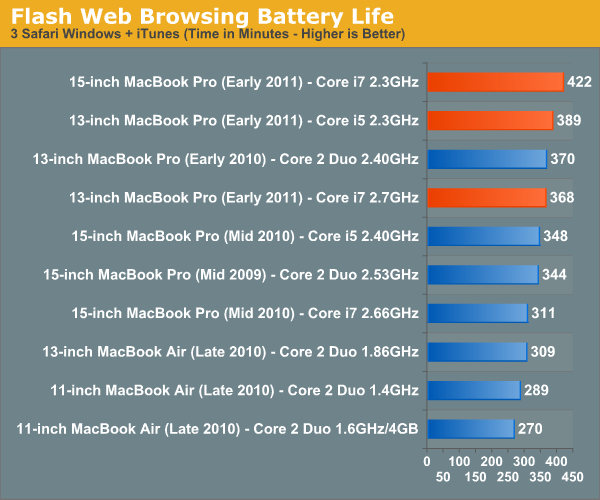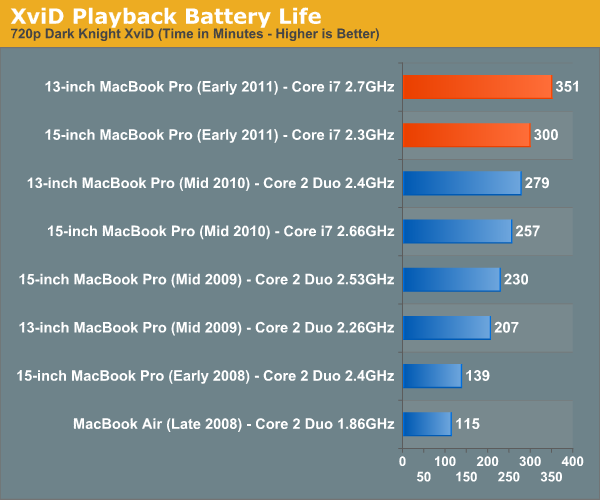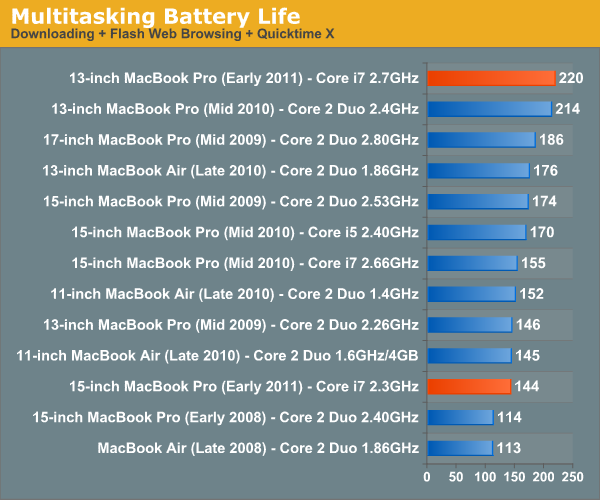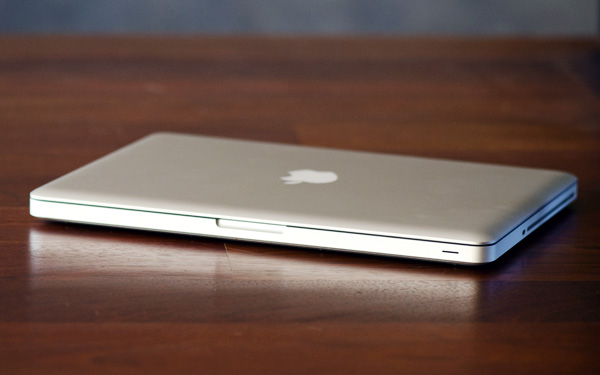The MacBook Pro Review (13 & 15-inch): 2011 Brings Sandy Bridge
by Anand Lal Shimpi, Brian Klug & Vivek Gowri on March 10, 2011 4:17 PM EST- Posted in
- Laptops
- Mac
- Apple
- Intel
- MacBook Pro
- Sandy Bridge
Battery Life
With the potential for higher power draw, battery life on these new systems has the chance to be really, really bad. In reality it breaks down like this: light usage cases are equal if not better than last year's model. Apple makes up for the higher core count of the 15-inch MBP by capping turbo speeds and being very good about allowing the CPU to go into deep sleep states under OS X. On top of that, Sandy Bridge is a very efficient microarchitecture that manages to get work done quicker than Arrandale and get to sleep faster.
Heavy usage cases however can easily be worse than last year's model, specifically with the 15 and 17-inch systems. The new 13 is a mixed bag. Core 2 was a pretty low power architecture, beating its battery life will be difficult. The only scenario our battery life tests don't duplicate is one where workload scales with performance. Right now all of our tests are fixed workloads: web pages may render quicker, but you'll still be idle for the same amount of time regardless of system. Video frames may decode quicker, but they'll still play back at the same 24 fps. If you use the additional performance of these systems to do more then you'll likely see even worse battery life (see the power numbers on the previous page).
Light Web Browsing
Here we're simply listing to MP3s in iTunes on repeat while browsing through a series of webpages with no flash on them. Each page forwards on to the next in the series after 20 seconds.
The display is kept at 50% brightness, all screen savers are disabled, but the hard drive is allowed to go to sleep if there's no disk activity. The wireless connection is enabled and connected to a local access point less than 20 feet away. This test represents the longest battery life you can achieve on the platform while doing minimal work. The results here are comparable to what you'd see typing a document in TextEdit or reading documents.

For the 15-inch model battery life has doubled since 2008. Even compared to last year's model Apple has actually improved idle/light usage battery life by 8%. With 9 hours of battery life I can confirm that if you're just using the 15-inch MBP as a glorified typewriter this is what you'll see. It's a great combination of a system that has performance on tap but the battery life to last you if you just need to do some writing.
The 13-inch MacBook Pro actually takes a step back compared to last year's model but it's still the Mac with the 3rd longest battery life.
Boot Camp Battery Life
Under Windows 7 there's no option to use the iGPU, the 15 and 17-inch MacBook Pros default to their dGPU. As we already showed, simply enabling the dGPU hurts battery life. What about the move to Windows 7 on top of that? To find out I ran our light web browsing battery life test under Windows 7. I subbed in IE8 and Windows Media Player for Safari and iTunes and otherwise ran with similar settings as our Mac test:

Compared to OS X with the dGPU enabled, Windows 7 delivers 20% lower battery life. The bigger penalty however is the forced dGPU usage under Windows. If you're planning on using the new 15-inch MBP as a Windows notebook, don't expect to get anywhere near the battery life that is promised under OS X.
Flash Web Browsing
The test here has three Safari windows open, each browsing a set of web pages with between 1—4 animated flash ads per page, at the same time. Each page forwards onto the next after about 20 seconds.
As always, the display is set to 50% brightness, audio at two bars, screensaver disabled and the hard drive is allowed to go to sleep if idle. The wireless connection is enabled and connected to a local access point less than 20 feet away.

Turn Flash on and up the intensity of the workload and the numbers get a lot more reasonable. The new 15-inch MacBook Pro leads the pack with 7 hours of battery life. You'll note that this is exactly what Apple promises on its website. At 7 hours this is also a 20% improvement over last year's model. Other than OS/optimization differences the only explanation I have here is that Sandy Bridge provides a sufficient enough increase in CPU performance to render a page and flash ads get to sleep quicker compared to Arrandale. Another contributing factor is the new 32nm iGPU which is active full-time under Safari. The GPU alone is probably a bit more efficient at rendering flash than last year's GeForce GT 330M.
The 13-inch model actually equals its predecessor. I suspect the Core 2 Duo is still a lower power CPU under a moderate load.
XviD Video Playback
I ripped The Dark Knight to XviD and played it back continuously in QuickTime X with Perian installed. For this test the display was set to full brightess and audio was set at two bars below maximum. Once more the hard drive was allowed to go to sleep if it was idle. The AirPort (wireless LAN) was enabled and connected to a local access point less than 20 feet away.

Multitasking Battery Life
Our final battery life test is the worst case scenario. In this test we have three open Safari windows, each browsing a set of web pages with between 1—4 flash ads per page, at the same time. We're also playing an XviD video in a window all while downloading files from a server at approximately 500KB/s.

I mentioned earlier that the new 15-inch MBP has the potential to have much worse battery life given that it has twice the cores of its predecessor. Our multitasking battery life test gives you a little indication of that. At 144 minutes the new 15 lasts just under 2.5 hours here. It's only a slight reduction compared to last year's model but that's only because the workload isn't scaled up at all. OS X is likely scheduling work here across all four cores rather than just two in last year's model, driving up power consumption and decreasing battery life ever so slightly.
The new 13-inch on the other hand is pretty sweet. At 3.66 hours it's the new king of our multitasking battery life test, and it's even a slight improvement compared to the 2010 version.
Just playing back movies on the new SNB notebooks is an improvement on both models. The new 15 manages 5 hours while the new 13 is good for almost 6 hours of battery life.
Overall I'd say the battery life story of the new MacBook Pros is a mixed bag. Under light to moderate workloads the 15-inch will likely do better than the 2010 15-inch MBP, while the 13-inch is roughly the same as its predecessor. It's only under heavy use that the new 15-inch will actually do worse than last year's model. You will have to keep an eye on what you're doing with the machine because the new 15-inch MBP has the ability to use a lot more power than last year's model. The bigger issue actually has to do with the dGPU. If you use Chrome or any of the other applications that will trigger the dGPU to turn on, kiss your battery life goodbye. Even light usage suffers if your discrete GPU is active.
The new 13 is a bit less finicky. It's either going to offer you similar or better battery life than last year's model.











198 Comments
View All Comments
brettski - Thursday, November 10, 2011 - link
Total NYC sales tax is 8.875%.NY state tax is only 4.5%
brettski - Thursday, November 10, 2011 - link
i'm sorry... state is 4%, city is 4.5%, plus Metropolitan Commuter Transportation District surcharge of 0.375%= 8.875% sorry... mixed up the city and state rates.gstrickler - Thursday, March 10, 2011 - link
What are you talking about? Most of us non-gamers don't even need a dedicated GPU, much less 256MB of graphics memory. I'm currently running on a late 2007, 15" MBP which has an 8600M GPU with 128MB of graphics RAM, and I only use it because there is no IGP on this machine. Once you get to the level of the Nvidia 9400M, IGP is plenty for a non-gamer, and even 32MB allocated to graphics RAM is more than adequate. The exception is if you need OpenCL support, since Intel's IGPs don't support OpenCL.I wish Apple offered a 13" MPB with a higher resolution (1440x900) matte display or a 15" with AES-NI and without a dGPU. I could use the faster CPU and HT, but I don't really need quad-core (but it's nice to have it available when on AC power), and battery life is far more important to me than a GPU or maximum CPU speed.
In fact, what I would really like is a 15" with matte display, no dGPU, Core i7-2720QM (for AES-NI support) with the ability to disable 2 cores/4 threads when on battery power. The 2011 15" lets me get close, if I use gfxcardstatus to disable the dGPU. If I can get software to disable 2 cores when on battery, it'll give me everything I'm asking for, but at a fairly hefty premium ($+150 for the matte display, $+400 for the Core i7-2720QM and Radeon 6750M + 1GB that I'll never use). Of course, what that means is that I'll either get the entry level 15" without AES-NI support and use gfcardstatus to disable the dGPU, or I'll wait for the next update and see if the options are any better.
Notes to Apple:
1. Make a matte screen an option on all machines, for no more than a $50 premium (no forced upgrade to a higher resolution)
2. Offer a 15" without a dGPU (e.g. make the dGPU a separate plug-in module)
3. Offer a 1440x900 screen for the 13" MPB.
I doubt I'll see any of those, but it doesn't hurt to ask.
tipoo - Thursday, March 10, 2011 - link
"Most of us non-gamers don't even need a dedicated GPU"Most people don't need a truck, that doesn't mean no one does. This is branded as a pro machine, and at nearly 2 grand the GPU doesn't fit the bill.
alent1234 - Friday, March 11, 2011 - link
MAcbooks are thin, long battery life, nice screen and good build quality first. specs second. until sandy bridge came out laptops with long battery life cost just as much as a macbook or more.a lot of the people that buy these are mobile pro's who need to use a laptop for hours while away from a power source
sync216 - Thursday, March 10, 2011 - link
256MB is fine for the 64xxM series GPUs. The performance improvement going to GDDR5 and a faster GPU is much higher than the improvement from 256 to 512 would have given. For customers who really need the additional graphics performance (and corresponding graphics memory) apple is offering the very fast 6750M with 1GB.Demon-Xanth - Thursday, March 10, 2011 - link
...Apple is more like Sony than Acer? Their core buisness is no longer computers, but gadgets.michael2k - Friday, March 11, 2011 - link
Um, this was evident in 2001 when the Titanium PowerBook was first unveiled, then the iPod later that year, then the music store in 2004, etc.Also, you have it backwards, their core business is computers, they just happen to know how to turn computers into gadgets. They treat the iPod like a computer (firmware updates on a regular basis), which means they aren't disposable. Contrast that to the average phone OEM with Android who won't see updates for longer than 6 months, where Apple pushes updates to their iPhone for over 29 months.
jameskatt - Friday, May 6, 2011 - link
Nearly all of Apple's products are computers:Mac Pro = desktop expandable computer running OS X
iMac = all-in-one desktop computer running OS X
Mac Mini = non-expandable desktop computer running OS X
MacBook Pro = high end laptop computer running OS X
MacBook Air = high end netbook computer running OS X
MacBook = basic laptop computer running OS X
iPad = tablet computer running OS X
iPhone = handheld tablet computer with phone running OS X
iPod Touch = handheld tablet computer running OS X
AppleTV = multimedia appliance computer running OS X
OS X has two variations - Mac OS X and iOS. The core operating system is the same for both.
Apps for both are written using Apple's XCode Development System.
quiksilvr - Thursday, March 10, 2011 - link
I'm surprised SSD isn't standard to begin with. $1199 for a 13" laptop and you don't even get dedicated graphics? Seriously? The HDDs aren't even 7200rpm. This is insulting to the nth degree.If you want a solidly built, well-spec'd, thin and fairly priced system, get the Envy 14. You get 7200rpm HDD, dedicated graphics, an HD webcam with TWO microphones (necessary for sound cancelling), a backlit keyboard and even Photoshop and Premiere.
Until Apple drops their prices to a realistic and reasonable level, avoid it completely.